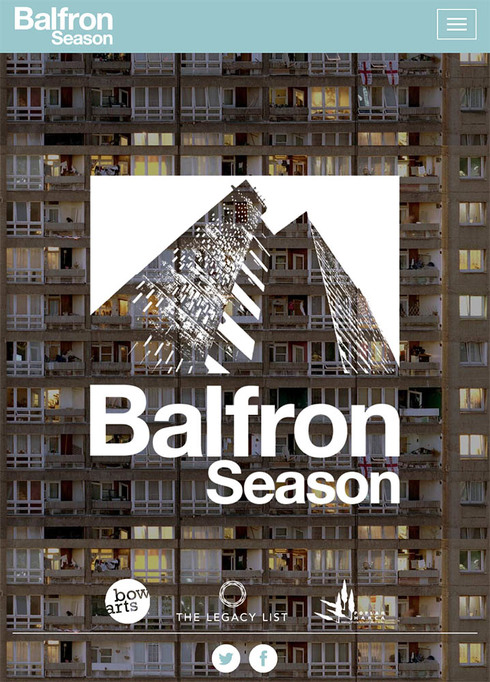
I have included excerpts below but encourage you to visit the website to see the full information and accompanying images.
Introduction
Balfron Tower is soon to be refurbished. Just before this begins, Bow Arts Trust has been given the the opportunity to curate a month-long programme of arts and culture to celebrate the life of the building and the people who have lived there.
Balfron Season runs until mid October and offers a range of experiences in Balfron Tower from art exhibitions, workshops, dinners and debates and Open House Walks. This interactive exhibition is supported by housing association Poplar HARCA and the Legacy List.
Programme
Balfron Season: Art, Architecture And Culture in the iconic Balfron Tower
A unique programme of events situated in and around the Grade-II listed Balfron Tower, a monument to Brutalist architecture and an imposing East London landmark.
Presented by Bow Arts, activity will run until mid October 2014.
Events include site-specific art installations as part of the Bow Artists’ Open Studio programme, architectural walking tours, an artist-led Supper Club, photography shows and panel discussions, and interactive print and drawing workshops. Details on what’s on and booking information can be found in the programme below…
About Balfron
The damage done to London during the world war two blitz added to the existing housing crisis in east London, with much of its Victorian housing stock already in slum conditions.
Post war town planning promised comprehensive redevelopment to address obsolescence, congestion, bomb damage and lack of repairs.
In 1951 the Lansbury Estate, now at the foot of Balfron Tower, was redeveloped in the style of a garden suburb. Balfron Tower, by contrast, is a dramatic departure in both building form and as an idea for how we would live. Commissioned by London County Council, Balfron Tower, known during development as Rowlett Street Phase 1, was begun in 1965 and completed in 1967. It was occupied in February 1968, when Goldfinger and his wife Ursula also moved in to flat 130 as part of an exercise in research and publicity. The press response was largely favourable, though one dispute was played out in the letters page of the Guardian, where Goldfinger was accused by a detractor of high-rise living of taking part in a shallow exercise of little sociological merit. Goldfinger seems to have envisaged himself building many more such blocks, indeed, envisaged this as the way London would develop, and defended his stay at the Balfron vigorously.
Of the first 160 families who moved into the tower, only two were not from the newly formed Borough of Tower Hamlets. Many had been rehoused so that one-time neighbours in local terraces would live on the same access galley of the tower. Goldfinger attempted to reinforce this sense of community by throwing parties at his flat where a whole access galley would be invited at a time, these events were popular with the residents. Whatever the consensus at the end of the Goldfinger’s stay in the tower, the position of high-rise blocks in the public imagination was essentially over-determined by the Ronan Point disaster of 16 May 1968, just a few weeks after the Goldfingers had left.